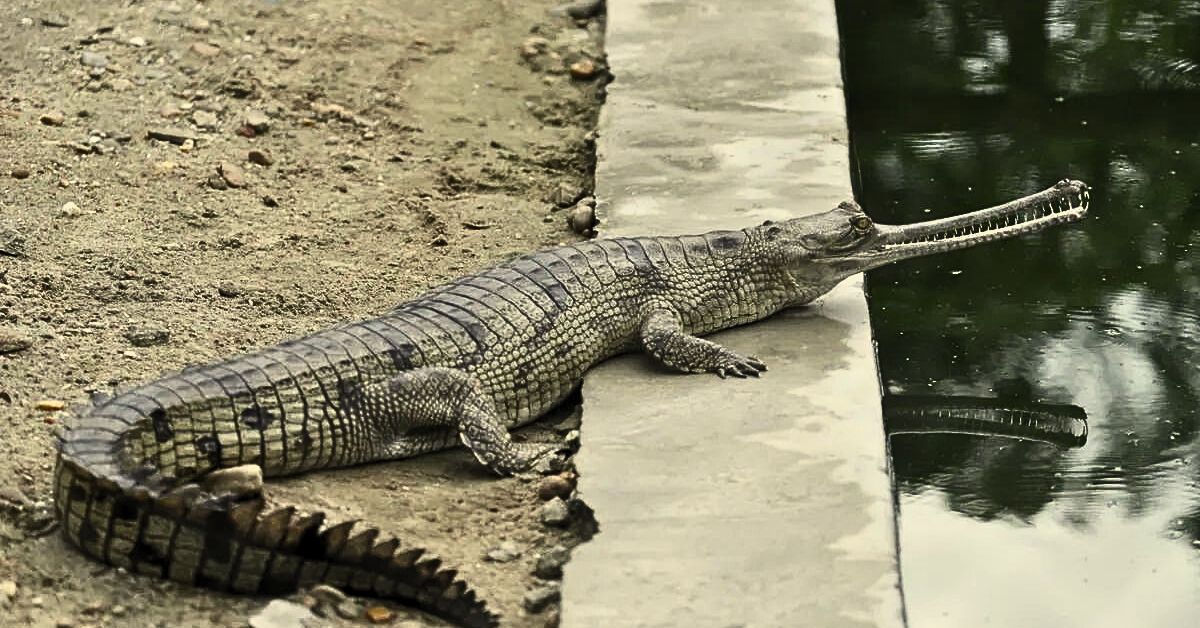
The gharial was thought to have vanished from the Brahmaputra river system in the 1950s, despite occasional reports of sightings in the 1990s
A solitary female gharial has recently captured attention in Kaziranga National Park and Tiger Reserve in Assam, temporarily outshining the renowned one-horned rhino of the world heritage site.
Wildlife officials and experts are puzzled by the gharial’s presence in the Brahmaputra River within Kaziranga National Park. However, they believe this nearly adult-sized reptile could be crucial in re-establishing the gharial population in the river.
Characterised by its long, narrow snout, the gharial (Gavialis gangeticus) was thought to have vanished from the Brahmaputra river system in the 1950s, despite occasional reports of sightings in the 1990s.
According to a news report published in The Hindu, this female gharial was first spotted in 2021 within Kaziranga’s Biswanath Wildlife Division, which covers 401 sq. km., 80% of which is water bodies, including a 107-km stretch of the Brahmaputra.
In January this year, during a 10-day survey of aquatic reptiles along the Brahmaputra, the same gharial, now 2.55 meters long, was seen twice basking just 500 meters apart in one of the three priority habitats.
The survey, conducted by the Turtle Survival Alliance Foundation India (TSAFI) and the Assam Forest Department, covered a 160 km stretch of the Brahmaputra from the Kaliabhomora bridge to Majuli’s Kamalabari Ghat.
The survey report, submitted in June, recorded 990 freshwater turtles from five species—Assam roofed turtle, Indian tent turtle, Brown roofed turtle, Indian or Gangetic softshell turtle, and Peacock softshell turtle—as well as over 80 other major aquatic species within the Biswanath Wildlife Division.
Among these was the Gangetic river dolphin (Platanista gangetica), which shares the gharial’s connection to the Ganges.
The Hindu report further added that the female gharial was the only one of its kind observed, moving between a sandy shoreline and a sandbar with a water depth of 4.5 meters.
Historically, gharials were distributed across the Brahmaputra, Ganga, Indus, and Mahanadi-Brahmani-Baitarani river systems in India, Bhutan, Bangladesh, Nepal, and Pakistan.
Today, their major populations are found in three Ganga tributaries: the Chambal and Girwa in India and the Rapti-Narayani River in Nepal.
ALSO READ | Gharial Breeding Site Found In Nepal
"Female gharials lack the ghara (a pot-like structure) on the snout, which males possess. We have limited knowledge about Brahmaputra gharials, but we know this female has been solitary for over three years and is nearly ready to breed," The Hindu reported, quoting Sushmita Kar, TSAFI’s project director in the northeast.
The survey report recommended the “high-priority” reintroduction of gharials in the Brahmaputra landscape, especially within the Biswanath Division, due to the “suitability of habitats for supporting the species’ long-term survival.”
It may be mentioned here that unlike the Chambal or other northern Indian rivers, the Brahmaputra is prone to flooding.
This female gharial has survived at least three floods, indicating that gharials, especially juveniles and sub-adults, can acclimatise and survive in the Brahmaputra and its channels.”
If approved, the reintroduction plan would likely involve bringing gharials from the Kukrail gharial breeding centre near Lucknow, Uttar Pradesh.
ALSO READ | Kaziranga Roars In Joy After 15 Years
The Story Mug is a Guwahati-based Blogzine. Here, we believe in doing stories beyond the normal.